Roasted Kabocha Squash Soup
This Roasted Kabocha Squash Soup is a creamy blend of roasted squash and lentils infused with the umami flavors of gochujang and miso. Easy to make and packed with protein to keep you satisfied and cozy during the winter months.

Looking for something to keep you cozy for the remainder of the winter? Well, this Roasted Kabocha Squash Soup will help do exactly that. It has the perfect velvety texture and uses many warming spices to help keep you well and cozy.
Why You’ll Love This Roasted Kabocha Squash Soup
- Completely dairy-free. No dairy milk is needed to make this soup creamy. The creamy factor comes primarily from the lentils, squash and plant-based milk.
- Easy to make. Just roast your squash and cook your lentils. Then blend both together until nice and smooth.
- Made with added plant-based protein. Because we are blending in some cooked lentils, we are getting the benefit of some added protein to our soup. This added protein makes this soup way more satisfying.
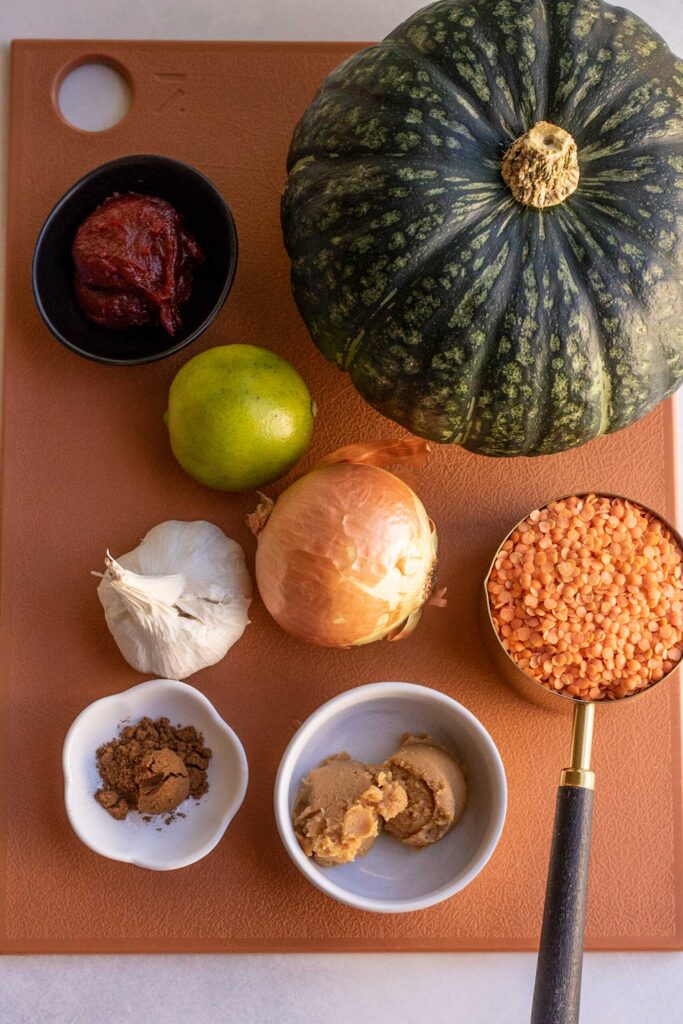
Key Ingredients and Substitutions
- Kabocha Squash: Can be swapped with a different squash like butternut squash or acorn squash. Just note these squashes contain more moisture compared to Kabocha squash. Please follow the FAQ recommendations below for swapping out the squash.
- Red Lentils: To preserve the color of the soup, I do recommend sticking to the red lentils if possible. If you do not have access to the red lentils you can use brown or green lentils and cook them for a little longer until soft and mushy. Just note, the color of the soup might change slightly due to this swap.
- Onion: Feel free to swap for a red onion or equal amount shallot if necessary.
- Garlic: Use a full head of garlic. Because we are baking it, it will mellow out the flavor of the garlic and enhance some of it’s natural sweetness.
- Miso Paste: I recommend white or yellow miso paste for this soup. If using red, I would stick to 1 tablespoon. If you are unable to tolerate soy, feel free to swap with equal amounts coconut aminos.
- Maple Syrup: Compliments both the kabocha squash and the gochujang. Feel free to use your favorite liquid sweetener as an alternative.
- Lime: Adds some brightness to the soup. You can also swap with a tablespoon of rice wine vinegar or apple cider vinegar.
- Gochujang: A Korean red chili paste that is used in many traditional Korean dishes. If not a fan of spice, feel free to omit it from the recipe. If you need an alternative, try swapping for 1 tablespoon of sriracha. Make sure your gochujang is gluten-free if avoiding gluten.
- Chinese Five Spice: This is a spice blend that offers a lovely balance of savory and sweet notes from the touch of cinnamon and anise. Highly recommend it as a way to balance the flavors from the miso paste and maple syrup.
- Cream: To keep this dairy-free you can use full-fat coconut milk or plain oat milk.
- Vegetable Broth: Use good quality vegetable broth to truly enhance the flavors of this soup. I like using a bouillon cube or paste to make my own vegetable broth, but any of your favorite boxed brands work wonderfully here too.
How to Make Kabocha Squash Soup
Preheat the oven to 400F and place a sauce pan on the stove over medium low heat. Add 2 teaspoons of avocado oil to the pan. Once the oil is warm, add the gochujang and sauté for about 2 minutes then add the ginger and sauté again for 1 minute.
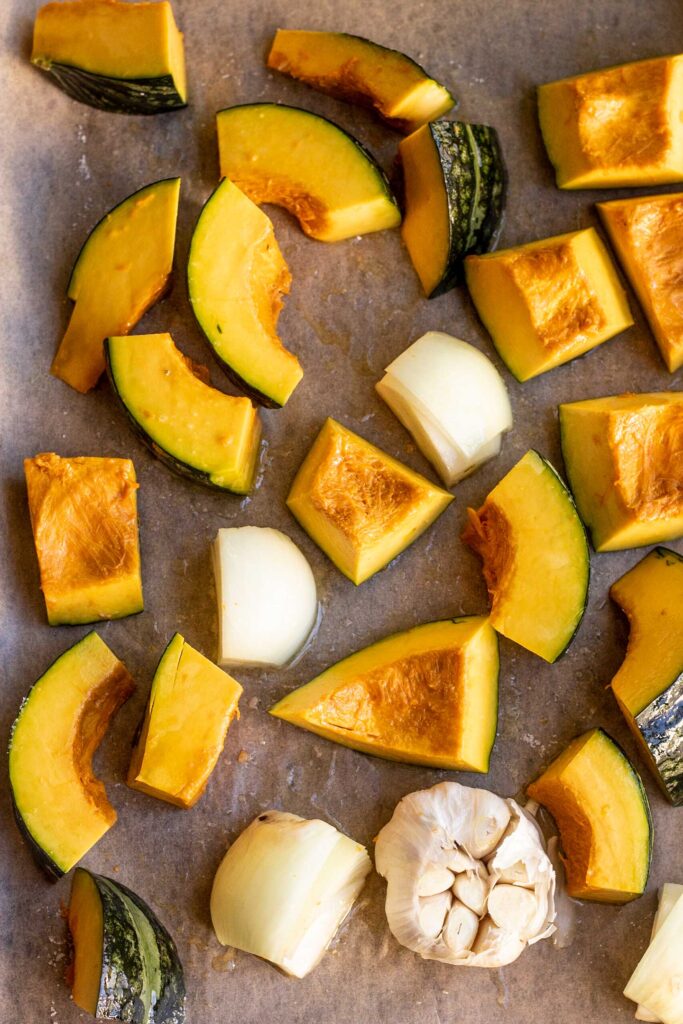
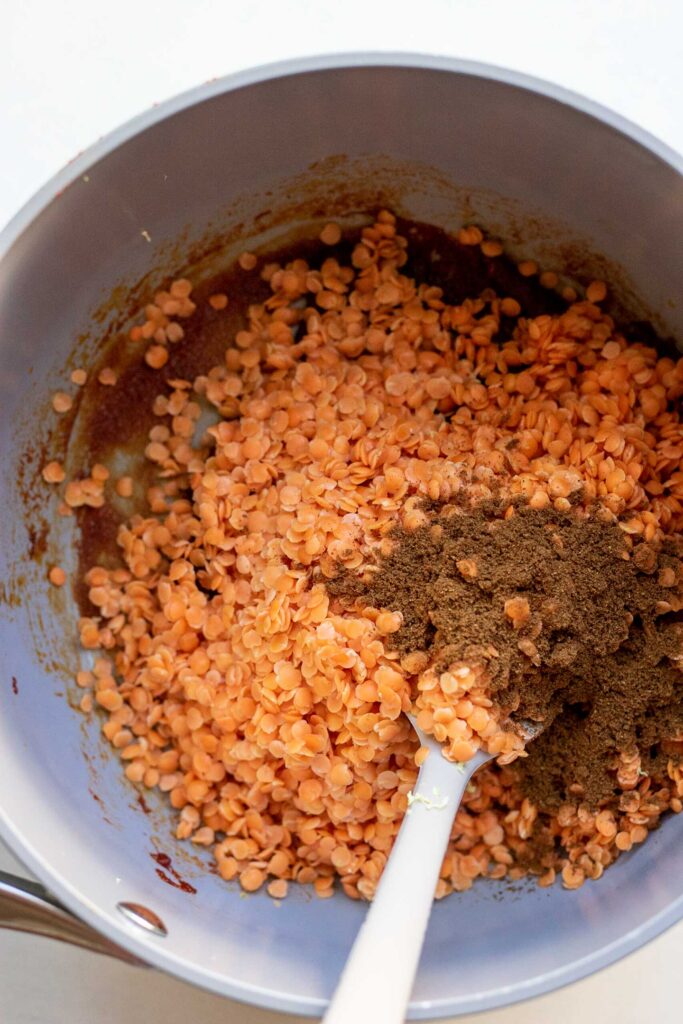
Add the red lentils, five spice and vegetable broth and give everything a good mix to combine. Bring the lentils to a boil then reduce the heat to low simmer and cook for 30 minutes without a lid.
While the lentils cook, cut your squash in half with a sharp knife, remove the seeds and then cut it into large chunks, leaving the skin on. Next, cut the top of the head of garlic off to expose some of the garlic cloves. Place the squash, garlic and onions on a parchment lined baking tray then pour the oil generously over the squash and exposed garlic cloves. With your hands, make sure the squash and onion is well coated in the oil, then cover the tray tightly with foil and place in the oven to roast for 35 minutes or until the squash is cooked through.
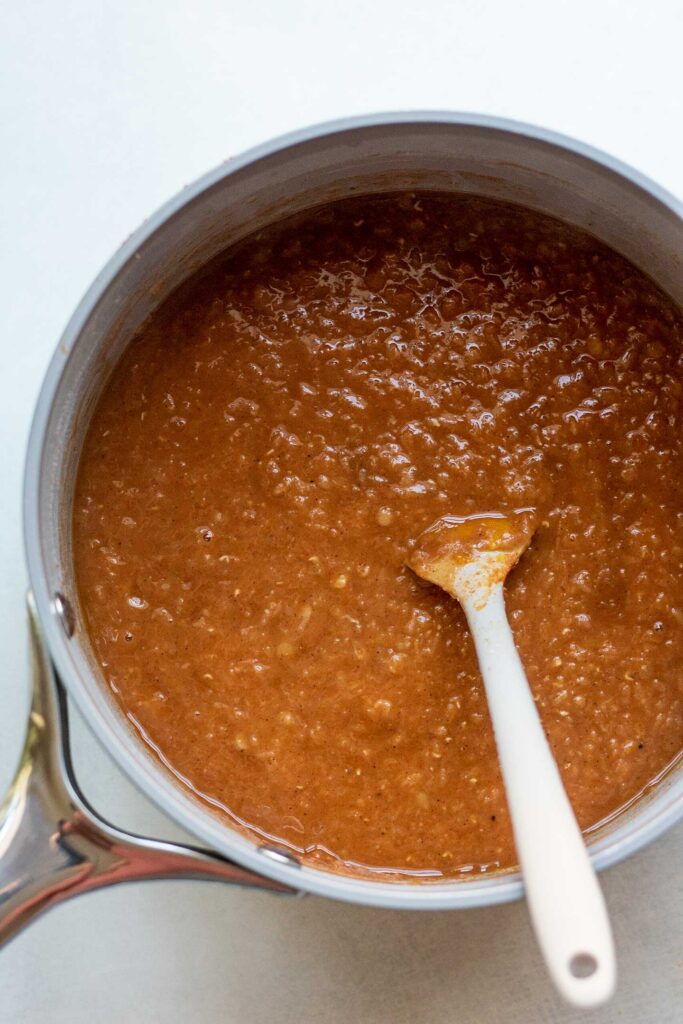
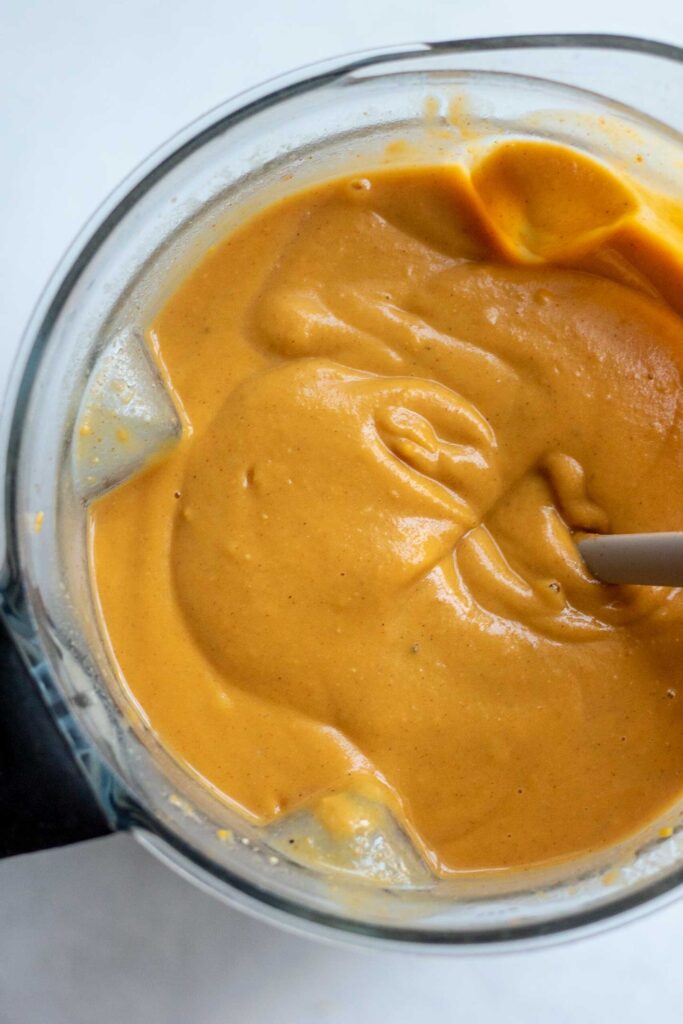
Allow the squash to cool for 5-10 minutes or until safe to handle. Peel or cut the skin off of the squash then add the squash and onion to a high speed blender and squeeze out the roasted garlic from the bulb into the blender cup. Pour in the lentils, maple syrup, miso paste, lime zest and juice and milk of choice. Blend on high until the soup is smooth then serve with any additional toppings as desired.
Expert Tips
- Be generous with the oil. Kabocha squash is a drier squash compared to some of the other winter squashes. Using enough oil will help to prevent your squash from drying out too much in the oven.
- Cover your baking tray. This will help trap more of the moisture in when baking, which will help prevent the squash from drying out too much and becoming hard.
- If sensitive to saturated fat, swap the coconut milk for oat milk. Just make sure you go for a plain flavor.
- Adjust the spice to your preference. For a milder spice to the soup, just use 1 tablespoon of gochujang. If you like it spicier, use 2 tablespoons. Feel free to leave the gochujang out if desired as well.
- Adjust the consistency of the soup with extra water or vegetable broth as needed. If the soup is too thick, add a little more water and blend again to get your preferred consistency.

Frequently Asked Questions
Yes! The main difference between different squashes is their level of moisture, so you may need less coconut or oat milk to blend with it. I would start with a cup of milk and add more to thin out the soup as desired.
If your squash dries out too much and becomes harder, place the pieces in a pan with 3/4 cup of water and bring to a simmer. Simmering for 4 minutes then remove and cool before removing skins.
If you want a lovely orange color, I suggest removing the skin. If aesthetics don’t bother you, you can leave the skins on when blending. The squash skin is completely edible.
Once the soup has cooled, portion into airtight containers and store in the fridge for up to 5 days. This soup can also be frozen and placed in the freezer for up to 3 months. For freezing, I highly recommend portioning into smaller individually portioned containers to make reheating the perfect amount that you need easier.

How to Serve
This cozy soup is a complete meal in one bowl, but you can serve this with a light side salad or if you want to add more texture, top with pepitas and enjoy with a few slices of some crusty toasted bread.
More Comforting Vegan Soups to Try
- Creamy Vegan Potato Soup
- Shredded Tofu Noodle Soup
- Vegan Gnocchi Tomato Soup
- Chipotle Red Lentil Potato Soup
- Mushroom Wild Rice Soup


Roasted Kabocha Squash Soup
- Prep Time: 20 minutes
- Cook Time: 40 minutes
- Total Time: 1 hour
- Yield: 6 servings 1x
- Category: Soup
- Method: Baking
- Cuisine: American
- Diet: Vegan
Description
This Roasted Kabocha Squash Soup is a creamy blend of roasted squash and lentils infused with the umami flavors of gochujang and miso. Easy to make and packed with protein to keep you satisfied and cozy during the winter months.
Ingredients
- 1–2 tbsp gluten-free gochujang (use less if sensitive to spice)
- 1 inch fresh ginger, grated
- 1 cup red lentils, rinsed
- 1 tsp Chinese Five Spice
- 4 cups vegetable broth
- 2 lb kabocha squash
- 1 head of garlic
- 1 medium yellow onion, quartered
- 2 tbsp avocado oil plus more as needed
- 2 tbsp maple syrup
- 2 tbsp yellow or white miso paste
- Zest and juice of one lime
- 1, 15 oz can of full fat coconut milk or 1 1/2 cups full fat oat milk
- Salt and white pepper to taste
Instructions
- Preheat the oven to 400F and place a sauce pan on the stove top over medium low heat. Add 2 teaspoons of avocado oil to the pan. Once the oil is warm, add the gochujang and sauté for about 2 minutes then add the ginger and sauté again for 1 minute.
- Add the red lentils, five spice and vegetable broth and give everything a good mix to combine. Bring the lentils to a boil then reduce the heat to a low simmer and cook for 30 minutes without a lid.
- While the lentils cook, cut your squash in half with a sharp knife, remove the seeds and then cut it into large chunks, leaving the skin on. Next, cut the top of the head of garlic off to expose some of the garlic cloves. Place the squash, garlic and onions in a parchment lined baking tray then pour the oil generously over the squash and exposed garlic cloves. With your hands, make sure the squash is well coated in the oil, then cover the tray tightly with foil and place in the oven to roast for 35 minutes or until the squash is cooked through.
- Allow the squash to cool for 5-10 minutes or until safe to handle. Peel or cut the skin off of the squash then add the squash and onion to a high speed blender and squeeze out the roasted garlic from the bulb into the blender cup. Pour in the lentils, maple syrup, miso paste, lime zest and juice and milk of choice. (Note: If you have a smaller blender, you may need to blend this in batches. Alternatively, you can add all the ingredients to your soup pot and use an immersion blender to blend everything until smooth).
- Blend the soup on high until the soup is smooth then serve with any additional toppings as desired.
Notes
Be generous with the oil. Kabocha squash is a drier squash compared to some of the other winter squashes. Using enough oil will help to prevent your squash from drying out too much in the oven.
Cover your baking tray. This will help trap more of the moisture in when baking, which will help prevent the squash from drying out too much and becoming hard.
If sensitive to saturated fat, swap the coconut milk for oat milk. Just make sure you go for a plain flavor.
Adjust the spice to your preference. For a milder spice to the soup, just use 1 tablespoon of gochujang. If you like it spicier, use 2 tablespoons. Feel free to leave the gochujang out if desired as well.
Adjust the consistency of the soup with extra water or vegetable broth as needed. If the soup is too thick, add a little more water and blend again to get your desired consistency.
If you tried this recipe or any other recipe on the blog, then let me know what you thought in the comments below! And if you loved it, don’t forget to rate it too. Feel free to follow on Instagram, Pinterest, and TikTok for the latest nutrition tips and recipe videos.
★ Catherine
This post contains affiliate links which means I will make a small commission if you purchase from those links. I only recommend and share products that I know, trust and personally use myself!





5 stars from all 4 members of my family so this is a 20-star recipe for us! So flavorful and the perfect way to use the kabocha squash we had sitting around.
Awww, you have no idea how happy this comment made me! Thank you so much for making this and so glad the family loved it. Definitely counting all those stars! 🙂